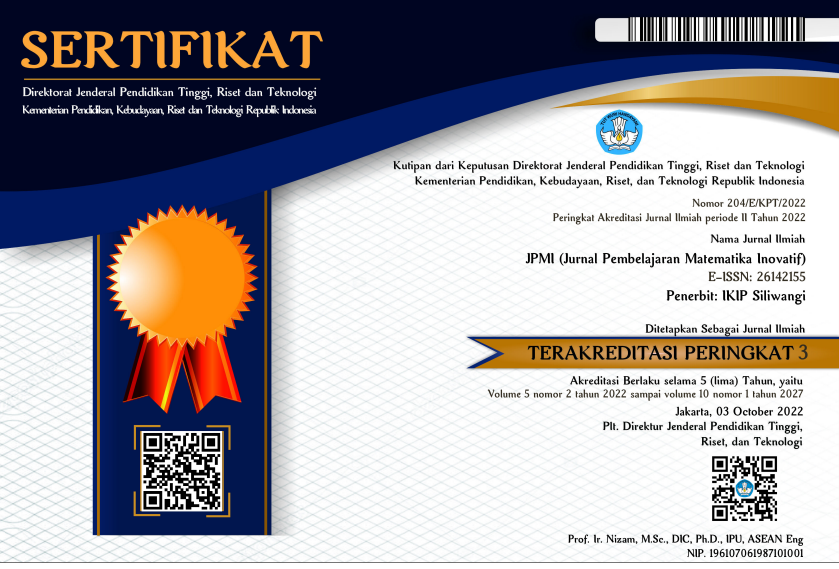KEMAMPUAN SPASIAL MAHASISWA MENGGUNAKAN GEOGEBRA PADA IRISAN KERUCUT
DOI:
https://doi.org/10.22460/jpmi.v5i6.11961Keywords:
Conic sections, GeoGebra, Spatial abilityAbstract
This study aims to describe the spatial ability of student to use GeoGebra in solvinf space geometry problems, especially in conical slices. The specific objective of this study are a) explaining the fluency of student using GeoGebra in solving problem in cone slices in the space analytical geometry lecture. The qualitative research method provides problems related to cone slices, which are then solved using GeoGebra. The research subjects are mathematics education students majoring in Mathematics and Natural Sciences Education (PMIPA) Faculty of Teacher and Education (FKIP) Tanjungpura University (Untan). They are studying spatial analytical geometry in the 2020/2021 year totaling 18 students. In this study, the instrument used was an instrument in the form of cone slice questions with its completion using GeoGebra; the instrument was designed to see the spatial ability of students based on five indicators. Through this research, the results were obtained that students fluency in using GeoGebra, in general is quite good, as well as students spatial abilities.
References
Abed, E. R., Al-Absi, M. M., & Abu shindi, Y. A. (2015). Developing a Numerical Ability Test for Students of Education in Jordan: An Application of Item Response Theory. International Education Studies, 9(1). https://doi.org/10.5539/ies.v9n1p161
Achdiyat, M., & Utomo, R. (2018). Kecerdasan Visual-Spasial, Kemampuan Numerik, dan Prestasi Belajar Matematika. Formatif: Jurnal Ilmiah Pendidikan MIPA, 7(3). https://doi.org/10.30998/formatif.v7i3.2234
Asngari, D. R. (2015). Penggunaan Geogebra dalam Pembelajaran Geometri. Seminar Nasional Matematika Dan Pendidikan Matematika UNY.
Bernard, M., & Setiawan, W. (2020). Development of Geometry Analysis Using Geogebra Scripting in terms of Student Cognitive Capabilities. Journal of Physics: Conference Series, 1521(3). https://doi.org/10.1088/1742-6596/1521/3/032103
Cantürk-Günhan, B., Turgut, M., & Yilmaz, S. (2009). Spatial ability of a mathematics teacher: The case of Oya. IBSU Scientific Journal, 3(1).
Erlinawati. (2018). PENGGUNAAN APLIKASI GEOGEBRA UNTUK MENINGKATKAN MOTIVASI PELAJARAN MATEMATIKA. Jurnal Prinsip Pendidikan Matematika, 1(1). https://doi.org/10.33578/prinsip.v1i1.21
Guzel, N., & Sener, E. (2009). High school students’ spatial ability and creativity in geometry. Procedia - Social and Behavioral Sciences, 1(1). https://doi.org/10.1016/j.sbspro.2009.01.312
Jayantika, I. G. A. N. T., Ardana, I. M., & Sudiarta, I. G. P. (2013). Kontribusi Bakat Numerik, Kecerdasan Spasial, dan Kecerdasan Logis Matematis Terhadap Prestasi Belajar Matematika Siswa SD Negeri di Kabupaten Buleleng. Jurnal Pendidikan Dan Pembelajaran Matematika Indonesia, 2(2).
Juandi, D., Kusumah, Y. S., Tamur, M., Perbowo, K. S., & Wijaya, T. T. (2021). A meta-analysis of Geogebra software decade of assisted mathematics learning: what to learn and where to go? Heliyon, 7(5). https://doi.org/10.1016/j.heliyon.2021.e06953
Maier, P. H. (1998). Spatial Geometry and Spatial Ability - How to Make Solid Geometry Solid. Selected Papers from Annual Conference of Didactics of Mathematics 1996, 3.
Rahayu, S. (2019). Standar Proses PERMENDIKBUD Nomor 65 Tahun 2019. INA-Rxiv Papers, 65.
Rahmawati, Y., Dianhar, H., & Arifin, F. (2021). Analysing students’ spatial abilities in chemistry learning using 3d virtual representation. Education Sciences, 11(4). https://doi.org/10.3390/educsci11040185
Salim, K. (2014). Pengaruh Globalisasi terhadap Dunia Pendidikan. University Teknologi Malaysia, January.
Sofia, N. (2021). PERANGKAT LUNAK YANG SANGAT BERGUNA UNTUK DI GUNAKAN DALAM PEMBELAJARAN SECARA DARING. Article.
Suliani, M. (2019). Analisis Representasi Matematika dalam Penyelesaian Masalah Geometri. Prosiding Seminar Nasional Integrasi Matematika Dan Nilai Islami, 3(1).
Trafton, P. R., & Midgett, C. (2020). Principles and Standards: Learning through Problems: A Powerful Approach to Teaching Mathematics. Teaching Children Mathematics, 7(9). https://doi.org/10.5951/tcm.7.9.0532
Za’ba, N., Ismail, Z., & Abdullah, A. H. (2020). Preparing student teachers to teach mathematics with GeoGebra. Universal Journal of Educational Research, 8(5 A). https://doi.org/10.13189/ujer.2020.081904.

















